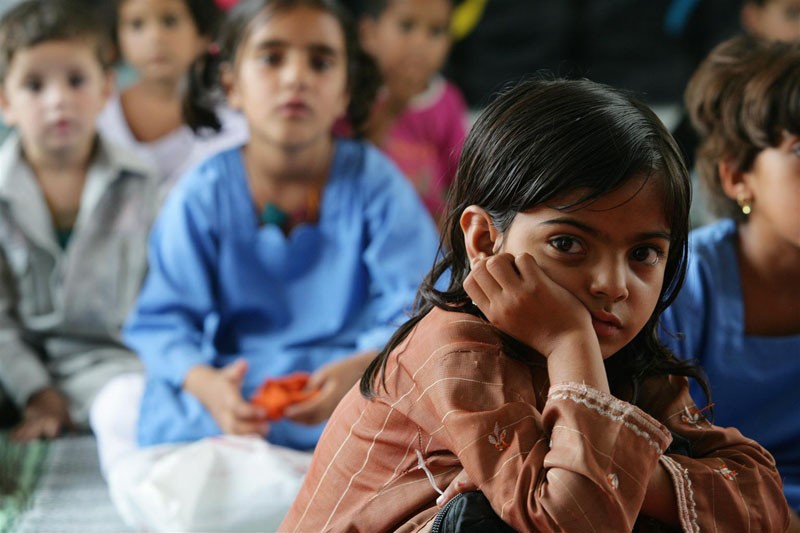
Keeping in view the poor state of education system, the target to achieve 100 per cent primary enrolment by 2018 seems a far cry

Federal Planning and Development Minister Ahsan Iqbal announced the launching of the month-long education campaign on April 1, 2016 in collaboration with the provincial governments to ensure 100 per cent enrollment in schools by 2018. This will help meet an international target set under the sustainable development goals. Prime Minister Nawaz Sharif and the four chief ministers will jointly lead a national campaign with the help of academia, civil society, politicians, media and local communities.
In reality, the chances of achieving the goal of 100 per cent enrollment in primary education by 2018 seem bleak because approximately 24 million children in the country are out of schools currently. Sindh and Balochistan with percentages of 51 and 66 respectively have the highest proportion of out-of-school children (OOSC). Punjab has 47 per cent out-of-school children. In Gilgit-Baltistan, 48 per cent children are out of school. Some 43 per cent of such children live in Azad Jammu and Kashmir.
In Khyber Pakhtunkhwa, the number stands at 800,000. In Federally Administered Tribal Areas (FATA) within there are 1000,000 children the age bracket of four to nine years. Of this, 400,000 children have been enrolled and 600,000 children are still out of school.
The existing trend of the literacy rate reveals a gloomy picture. The state of education, instead of improving, has deteriorated slightly from the previous years. The number of children that are currently going to schools is plummeting. Provincial literacy rates show that Punjab and Khyber-Pakhtunkhwa (KPK) governments managed to improve literacy ratios while Sindh and Balochistan could not even maintain their previous levels. In 2013-14, the literacy rate dropped by 3 per cent to 43 per cent in Balochistan and by 4 per cent to 56 per cent in Sindh. Pakistan Social and Living Standards Measurement Survey (PSLM) reported that in 2012-13 the overall literacy rate estimated at 60 per cent had gone down to 58 per cent in 2013-14. The same literacy rate also remained in 2015.
In 2001, under the United Nations Millennium Development Goals (MDGs), Pakistan had to increase its literacy rate from 48 per cent to 88 per cent by 2015. To achieve the targeted literacy rate, Pakistan had announced development plans such as National Plan of Action 2001-2015 and Education Sector Reforms (ESR). Regrettably, after 15 years of efforts, the results have been disappointing. We have succeeded in getting only an additional 10 per cent children enrolled in schools. In 2015, the overall literacy ratio stood at 58 per cent.
This brings us to another important aspiration -- the elimination of gender disparity for which education is a pre-requisite. Without education, the goal of women empowerment will at best remain a dream. Pakistan was expected to achieve full gender equality in primary enrollment as well as youth literacy by the year 2015; however, figures show an alarming gender disparity in education. The female literacy percentage is also coming down. The male and female literacy rates stand at 70 per cent and 47 per cent respectively. The difference between the two statistics is an issue of grave concern and should compel authorities to take swift action aimed at bridging the gap.
UNESCO Director General Irina Bokova said, "We will never achieve any of the Sustainable Development Goals without overcoming the discrimination and poverty that stunts the lives of girls and women from one generation to the next. We must work at all levels, from grassroots to global leaders, to put equity and inclusion at the heart of every policy so that all girls, whatever their circumstances, go to school, stay in school and become empowered citizens."
Unfortunately, Federal Minister for Planning, Development & Reform, Ahsan Iqbal, seems to be unaware of the existing deplorable condition of education in rural areas of the country. There are thousands of schools that are closed due to lack of teachers, a bad law and order situation and political interference. There is no sign of girls’ schools in a large number of remote villages in the country. Illiterate and poor parents are reluctant to send their children -- especially girls -- to study in schools. Another factor that hinders progress is that appointments, transfers and postings of teachers are made on the basis of favourtism. As a result, there are many schools that have a large number of enrolled students, but are facing a shortage of teachers. There are schools on the other end of the spectrum too -- ones with small enrollment of students and huge force of teachers.
In the 2015-16 budget, 2.68 per cent of GDP has been allocated for education collectively by the federal and provincial governments which is insufficient for improvement and development of the education system. Obviously, more money is required to construct new school buildings and additional classrooms with basic facilities.
The fundamental fault in the education system, which wreaked havoc, is its transitory policies. Almost all successive governments have thrown out policies of previous governments and come up with their own new policies. There is a dire need for long-standing and irreversible education policy that is worked out unanimously by all the major political parties.